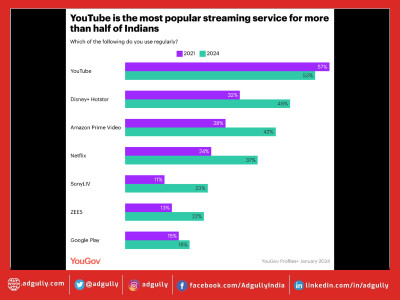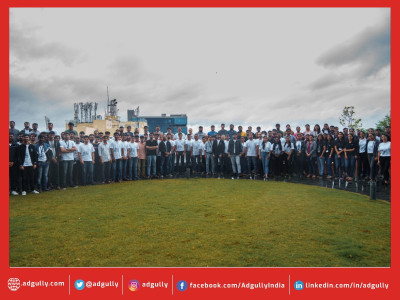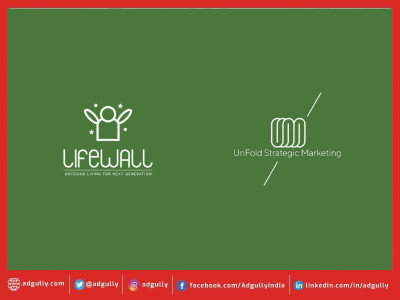Will digital hold on to No. 2 spot in terms of ad spends during peak festive season?
Digital media has been fairly resilient to the shockwaves caused by the COVID-19 pandemic. In H1 2020, digital advertising contracted by 7 per cent, compared to print and TV, which showed a degrowth of 51 per cent and 43 per cent, respectively, according to the Pitch Madison Advertising Report 2020 (PMAR'20). During the same period (H1 2020), digital grew its share of the AdEx pie to 30 per cent, firmly displacing print to become the 2nd largest media after television. Digital was showing a strong double-digit growth annually and growing its share of budgets from 6 per cent in 2011 to 23 per cent in 2019. Will the disruption in the traditional media landscape allow digital to cement its place at No. 2?
“In the initial months (April-May-June-July), we saw a downfall in ‘ad spends’ on platforms from traditional brands. Parallelly, due to the video consumption spike in digital entertainment, brands saw a humongous growth in subscription and ad revenue. The gaming business was a comfortable second during this period, spending on video ads. It will not be fair to put a number to this currently, but I think somewhere around October-November, we should have some clarity on the percentage growth,” remarked Preetam Thingalaya, Director of Media, Mirum India.
Similarly, Shubham Jha, Sales Manager India, Adjust, observed, “While it’s been a challenging year for the advertising sector as a whole, spending on digital video advertising has remained fairly stable. A recently released report from the IAB shows their pre-COVID 2020 estimate average spend per advertiser on mobile video ads would reach $14 million. This figure was adjusted slightly post-COVID to $12.1 million, showing that the industry and format has been largely resilient to the overall market turbulence.”
According to Neena Dasgupta, CEO & Director, Zirca Digital, “Amidst the lockdown and work-from-home, users are majorly consuming data on their mobile phones and televisions. While sectors like edutech, OTT entertainment, and gaming have risen in users and time spent, other sectors with which otherwise were high spenders in terms of online advertising, are facing hard times which ultimately impacts the overall ad revenue for platforms like YouTube.”
While the overall consumption story in digital media is very positive, we can see that similar to TV the hike in consumption did not necessarily translate to spends on digital advertising. The digital advertising pie is led by search, video, display and social media advertising with each contributing to about 20-30 per cent of the total. According to the PMAR'20 report, although there was a tremendous surge in video consumption, this did not translate to ad spends. Social media spending increased because brands needed a platform to drive saliency in the absence of print media. The more targeted display advertising actually saw a sharp decline in spends while search and e-commerce held on to their share.
We can extrapolate from the data that digital AdEx has reached the No. 2 spot not because of growth in spending, but due to the nature of the platform to better withstand the disruption caused by COVID-19. Will brands increase spending on digital platforms once the economy returns to good health? According to Jha, “although, many brands still plan to spend big on digital video advertising, the impact of COVID-19 may force marketers to focus even more closely on RoI and efficiency. We’re likely to see shorter, more impactful video ads catering to the attention span and rapid scroll behaviour of mobile users, with six-second shorts likely to be the apex of this model.”
Dasgupta stated, “While we have seen altering marketing strategies due to increase in the use of digital space, the slowdown of the economy has impacted ad revenues too. Sectors like FMCG, beauty, fashion, travel and automobile, the high spenders in the digital ad space, have suffered majorly due to lockdown, have significantly cut their marketing spends.”
While video was the undisputed champ on digital during lockdown, Thingalaya opined that in terms of spends, “the next in line will be search and then social, as major spends are inclined towards performance media. As we observed that many ‘non-digitally active brands’ also exploring digital. Search – nicknamed ZMOT (Zero Moment of Truth Platform) – as a consumer that is our first point of contact. We search for everything these days and this comes naturally to us. This is a habit we have developed over time. The reason it is second is because our time spent is lesser compared to video.”
The findings of PMAR'20 report and industry observers concur that advertisers who sustained and even increased their share of AdEx in 2020 were e-commerce, entertainment, edu-tech, food-tech, fin-tech, FMCG, gaming, groceries, government, health tech and healthcare. “Entertainment, specifically OTT, EComm – Retail and Online Food delivery has seen at least 2X growth in ad spends,” pointed out Thingalaya, adding, “Gaming and Online Education saw a huge spends growth online.”
“Prices were also coming down, because the availability of inventory was going through the roof – so gaming and entertainment apps in particular were in a strong position to increase spend and reach more users to offer them entertainment,” reflected Jha.
Growth Drivers Post COVID
Advertisers are returning to print and during festive season they rely heavily on tactical communications via newspapers. As Mirum’s Thingalaya said earlier, the peak festive months of October-November will be a true litmus test of whether digital’s time has come. While the unnaturally high consumption of digital media will return closer to normal, we see a medley of new and old trends playing a part in the growth story of digital.
“Rural is leading the way for digital growth in India. There is a report stating that there is a 45 per cent growth in rural internet audience in 2019, compared to urban India’s 11 per cent. Additionally, 2020 should see at least 300 million+ active internet audience in rural India. All in all, India should have grown to around 600 million+ active internet users during the COVID period 2020,” felt Thingalaya. Rural India has also seen the least impact of the pandemic both in terms of density of COVID-19 cases and strictness of Government imposed lockdown. Hence, these markets have been less impacted by the headwinds of the pandemic. Whether advertisers will rely on local print media or digital to reach these audiences is anyone’s bet.
Another anticipated growth driver will be the Indian Premier League 2020, which is expected to bring a lot of positivity to the festive season. There is a strong correlation of positive sentiment loosening purse strings, and advertisers will take every opportunity to reach a happy consumer.
Dasgupta is bullish on the prospects of digital. She said, “As far as the festive season is concerned, digital will take the lead in the absence of traditional media. It will be a digital-first media strategy for the festive season this year – and perhaps for every year to come.”
The PMAR'20 report noted that advertisers have begun offering TV plus (TV + OTT) combined deals to advertisers, especially for their impact properties. This will grow the digital AdEx pie in two ways.
First, let’s take the example of movie premieres skipping theatres and happening on TV and OTT platforms. Thingalaya observed, “When comparing TV’s appointment viewing to OTT’s View on Demand, TV might end up giving a spike in viewership for that three hours for the three times the movie is shown on that channel, however, the same movie on OTT starts with a spike and then keeps giving in incremental reach on a week on week basis. (Assuming it is Free to watch – AVOD). As one user might watch the movie twice and the OTT platform will keep getting newly acquired users to add to the user growth.” On its own, OTT still has a small base of users, but it has enough incremental audiences to justify a combined deal with TV.
Second are sponsorships. “I also feel once everything normalises, we will see the same movie with two separate sets of ‘sponsors’ on TV and OTT platforms, which should add to further growth,” Thingalaya added. This is already happening in the GEC space for marquee non-fiction properties like ‘Bigg Boss’, ‘KBC’ and 'IPL'. The opportunity is yet to be fully explored for fiction offerings that dominate the GEC space and niche channels.



















Share
Facebook
YouTube
Tweet
Twitter
LinkedIn